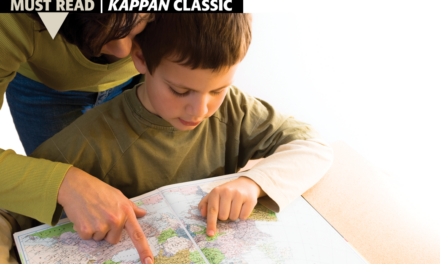Schools are increasingly unable to serve their original purpose of creating a shared civic community. What does this mean for their relationship to the state?
The nation state and the public school grew up together during the 19th century, with each enabling the development of the other. Public schools gave the emerging nation state a way to turn subjects of the crown into citizens of the state by drawing a dispersed, dissociated, and culturally heterogeneous populace into a civic community with shared experiences and a shared national identity. At the same time, the emerging nation state provided schools with the fiscal, ideological, and political support that enabled them to evolve into the massive public enterprise they are today. No nation, no school. No school, no nation.
But now in the 21st century, the relationship between state and school has become increasingly dysfunctional. They continue to need each other as much as before, but each is less able than before to meet the other’s needs. Over the years, U.S. public schooling has developed into a massive educational structure that requires an equally massive amount of public funding — more than local, state, and federal governments are willing or able to provide. As a consequence, we have seen growing shortfalls in public funding for public education.
In addition, the educational system has created a meritocratic structure for allocating occupational positions in the U.S. based on educational credentials. This has promoted the growth of a deep social divide in the country between those who acquire bachelor’s and graduate degrees, which qualify them for the positions with the greatest salaries and social esteem, and those with less than a bachelor’s degree, which leaves them with jobs that are crucial to the functioning of society but that generally trail behind the jobs of college grads in pay and prestige. This division between educational winners and losers has fostered a toxic political culture, largely lacking in shared values and mutual respect and thus unable to craft legislative compromises or even to admit electoral defeat.
To understand the factors that brought about this increasingly dysfunctional relationship between state and school in the U.S., it’s helpful to look back at the history of this relationship. Although schools were essential to developing a shared national identity, once the nation state became fully established, it was no longer so dependent on schools. States became naturalized and self-justifying as they came to be the indispensable machinery for defending the populace against outside threats and providing for the health, wealth, and welfare of its citizens. Once the state was armed with the legitimate power to extract taxes and compel compliance from its citizens, it was able to shed its early fragility and stand solidly on its own institutionalized feet.
And once schooling was fully established, it was able to expand on its own momentum and develop its own organizational structures, professional careers, and institutional interests. In this advanced form, schooling in the U.S. has come to consume one-sixth of the lives of its citizens and one-third of state appropriations. Along the way, schools acquired new social missions beyond the formation of civic culture, in particular by providing the skills needed to supply the economy with productive workers and by providing the credentials that enable individuals to get ahead and stay ahead. All this made schools the indispensable foundation for people’s hopes for themselves and their children.
So where does this leave us today in understanding the interrelation of school and state?
Three functions of schools
Currently, schools serve three important functions for the state:
- Legitimacy. The presence of public schools enables the state to portray itself as overseer of a fair system of social opportunity for its citizens. The meritocratic structure of schooling also provides a credible rationale for the social inequality among citizens by providing a structure for determining what jobs people deserve.
- Economic productivity. Schools are also seen as the essential mechanism for producing the human capital the state needs to fuel economic growth.
- Civic community. Schools remain an important factor in establishing and maintaining civic culture.
It turns out that schools are much more effective at accomplishing the first of these than the other two, although the first alone is more than sufficient to justify the state’s huge investment in schooling.
Legitimizing the state
The modern nation state needs the consent of its citizens to govern effectively. Even authoritarian states rely on a degree of ideological support to ease the burden of constant domination, which is enormously expensive and has a stifling effect on economic activity.
A central component of this justification arises from the meritocratic belief that social position is supposed to derive from individual accomplishment rather than accident of birth. Schools are the ideal instrument for promoting, measuring, and certifying personal achievement. As a result, school credentials have become the formal criterion for determining what jobs people are best suited to hold and thereby establishing their positions in the social hierarchy.
Universal public schooling did not arise to promote social meritocracy. Rather, it came into existence to, as Eugen Weber (1976) put it in the title of his book, turn Peasants into Frenchmen — part of the monumental task of building a nation out of thin air. In most countries, school systems emerged and grew long before education was seen as economically useful. But once schools were firmly in place, they gradually emerged as the primary pathway by which families could secure the future of their children and employers could establish the qualifications of job applicants.
These developments turned out to be a godsend for the state. Social inequality is the norm in societies, both old and new, but it poses a particular problem for the modern state because the state’s existence depends on the consent of the governed, even in the face of inequality. A formally meritocratic system of universal schooling establishes a visible and credible mechanism for allocating social positions according to individual achievement. If unequal social outcomes appear to be justified by personal merit — where people get what they deserve — then the state’s legitimacy is assured. This remains true even if the degree of inequality in society is extreme — as is the case in the U.S. today.
To acquire experience with meritocratic competition and thus learn the norm of individual achievement, you need a level playing field.
Schooling does not need to be fully meritocratic for its legitimizing power to be effective. In practice, birth is a strong predictor of academic achievement, degree attainment, and social outcome in modern societies. More often than not, people end up in the same social positions as their parents. But schools do make it possible for a sizeable number of students to get ahead of their birth status and for a lot of others to fall back. The possibility of upward and downward social mobility is real, even if the probability is rather low. Without schools, this mobility would not be possible.
Consider the alternative to socializing the young through schooling, the age-old process of socializing them in the family (Dreeben, 1968). Parents have a natural bias toward promoting the interests of their children over other people’s children, and they do what they can to pass on whatever advantages they possess. Parents send their children the message that you’re special because of who you are rather than what you’ve done. In addition, the children in the family are stratified by birth order, which gives the older children built-in advantages over their younger siblings. There is little possibility for fair competition within a family, because the oldest almost always wins.
To acquire experience with meritocratic competition and thus learn the norm of individual achievement, you need a level playing field. Through the magic of a 19th-century invention, the age-graded classroom, schools provide exactly that. Instead of competing against siblings, youths compete against peers at the same developmental stage. In addition, students in the classroom find themselves under the supervision of a teacher who is supposed to assess students based on academic performance, as opposed to assessing them according to the ascribed conditions of class, race, nationality, or gender. Of course, these factors do have an impact in practice, more with some teachers than others. But such teacher bias is considered a violation of a widely held norm.
So schools perform a yeoman’s service for the state by legitimating its rule, even in the face of radical social inequality. All by itself, that’s quite an accomplishment. What about productivity?
Enhancing economic productivity or not so much?
A central belief of contemporary economics and international educational policy is that education is the key to economic development. Today, it is hard to find a political speech, reform document, or opinion piece about education that does not include a paean to the critical role education plays in developing productive skills and spurring economic growth. The success of the state rides on the productivity of its economy, so schools are potentially doing a great service to the state by training productive workers — but only if indeed they can do so.
The correlation between increased schooling and economic growth is certainly quite impressive. Between 1900 and 2000, the average education level in the U.S. rose from 8th grade to two years of college (Goldin & Katz, 2008, p. 19), and gross domestic product per capita rose from $8,000 to $46,000 (Our World in Data, 2022). The problem is that while education levels were rising rapidly during the 19th century, industrialization was driving the skill levels of the workforce lower. So for most of the century, the primary value of schooling was political rather than economic. People saw the offer of free public education as the right of citizens in a democratic society rather than as an aid to getting a good job.
It wasn’t until the 1890s, with the rise of white-collar bureaucratic work in corporations and state agencies, that education in the U.S. became a hiring criterion, a pattern that has accelerated to the present day. There’s a certain economic logic to this connection. It’s clear that literacy and numeracy skills can make workers more productive in clerical and managerial work. But it’s less clear that high achievement in the academic subjects taught in high school and college makes you economically more productive.
The success of the state rides on the productivity of its economy, so schools are potentially doing a great service to the state by training productive workers — but only if indeed they can do so.
In light of these considerations, it’s hard to establish that education was the cause and economy the effect in this story. The workforce was becoming more educated, but the presence of educated workers was not necessarily the source of increases in economic productivity. It could just as easily have been the other way around. Producing large numbers of high school graduates (and later, college graduates) has been enormously expensive. But strong economic growth provided enough of a fiscal surplus that state and local governments were able to afford to do so. In short, it’s quite plausible that economic growth is what made educational growth possible.
We expanded high school because we could afford to, and we’ve done the same with college and graduate school. And we wanted to do so, not because we thought it would provide social benefits by improving the economy, but because we hoped it would provide us educational consumers with personal benefits. Middle-class families saw high school and college as a way to gain or maintain an edge in the competition for good jobs. And working-class families saw high school as a way to provide their children with the possibility of a better life than their own (Labaree, 2010, chap. 7).
Bottom line: Schools may not do much to support the state by promoting economic growth, but they nonetheless get a lot of credit for doing just that. In balance, that’s a win for schools if not the state. So what about community?
Reinforcing or undermining civic community?
The state still needs schools to play a version of the role they assumed at the beginning of universal public education: to build and reinforce civic community, social coherence, and shared values. As Benedict Anderson (1998) shows, this involves creating and reproducing citizen’s sense of being part of the “imagined community” we call a nation state. The formation of such a community doesn’t just happen; it needs to be created from scratch. And especially in an immigrant society such as the U.S., the arrival of large numbers of newcomers, with their own norms and values, continually challenges civic coherence. For this reason, having a vehicle for incorporating multiple nationalities and ethnicities into a single national culture has been critical.
Unfortunately, schools are not playing the same role of community builder that they did in the early phase of their existence. U.S. schools do continue to provide an important service by initiating large numbers of immigrants in U.S. culture. But they are increasingly ineffective in reinforcing the shared culture of native-born Americans. In fact, they have been instrumental in constructing the new credential-based hierarchy that is becoming a central axis of division in American life. Look at the presidential elections results for 2016 and 2020, and you will see that a key difference between Republican and Democratic electoral districts is the proportion of voters who attended college (Cohn, 2021).
This new education-based meritocracy legitimizes inequality while demeaning those who are less educated, no matter how great their contribution to the public good. The idea is that if education enables people to make it to the top through smarts and hard work, then it follows that those on the bottom deserve to be there. By default, they come to be seen as being less worthy — dumb, lazy, useless.
The problem with this depiction is the assumption that the social positions requiring the most education and carrying the highest levels of pay and prestige are also the most socially beneficial. Certainly the highly credentialed people who occupy the highest levels of the professions, media, academia, and business play an important role in making modern societies function, but it’s not at all obvious that their work is so much more beneficial to society than that of the less-educated citizens who earn markedly less money and respect.
The state still needs schools to play a version of the role they assumed at the beginning of universal public education: to build and reinforce civic community, social coherence, and shared values.
The COVID-19 pandemic has made this paradox vividly evident. When we had to decide which members of the workforce were essential and which were not, it turned out that the most essential workers were often those who lacked elite educational credentials but played social roles that we could not do without. The world didn’t grind to a halt when most meritocrats stopped going to the office, but it would have if first responders, health care workers, supermarket clerks, truck drivers, personal care aides, trash collectors, transit operators, plumbers, and repair technicians also had stayed home. For a short time, the uncredentialed members of the working class and lower middle class became social heroes. However, this momentary rise in prestige didn’t last.
When hardworking people, who have long been the object of public esteem, find themselves in a state of economic insecurity and declining respect, they naturally seek political redress for their grievances. And the natural target of their anger is the credentialed elite who developed a monopoly on society’s monetary rewards and public respect. The result in the U.S. is Trumpism and the culture wars that are making American politics so dysfunctional. It’s hard for a democracy to operate effectively when its citizens no longer feel that they are part of the same civil community. Opposing factions no longer have shared values and a common ground that can serve as the basis for political compromise.
So we have come around full circle in this argument. Schools are crucial in establishing the legitimacy of the state. But the current meritocratic educational regime, with its emphasis on college credentials as the basis for position and prestige, has created a social fissure that sharply undermines this political legitimacy. Schools can provide support to the state, but they can also take it away.
State support for schools
While schools’ support for the state has become more and more shaky, the support that the state provides for schools has been — until recently — strong and growing. It has had to be because schooling in the 21st century is massive and enormously costly. In the U.S., there are 50 million public school students and 3.2 million public school teachers spread across 100,000 schools in 13,000 school districts (Riser-Kositsky, 2022). The total cost is almost $800 billion or $15,621 per student (National Center for Education Statistics [NCES], 2022b). Of this, states and local school districts each pay nearly half, with the federal government providing only 7% (Education Data Initiative, 2022). Meanwhile, there are 14 million students (NCES, 2022a) and 1.9 million faculty and staff at 1,600 public colleges and universities (NCES, 2021). State and local governments spend $311 billion on public higher education (Urban Institute, 2022), and the federal government spends another $33 billion (NCES, 2021b), which comes to $24,600 per student.
Two important points emerge from these data. First, the fiscal burden of education on governments is staggering — more than $1 trillion a year. For state governments, the cost of public schooling and public higher education makes up a crushing 30% of the total budget (Ballotpedia, 2015). Second, schooling is much more expensive per student as students move up through the system. High school costs more than elementary school, college more than high school, and graduate school more than college. The cost per student for higher education is twice the cost for K-12 education. Since the average level of education in the U.S. has been rising dramatically over the years, this means that the public cost of education has also been trending sharply higher over the last 140 years with the sharp expansion of high school enrollments and over the last 70 years with the sharp expansion of college enrollments.
Sooner or later, this combination of factors was going to produce a fiscal crisis for the state. After all, how long can the state keep paying for additional and increasingly costly years of schooling for its citizens while simultaneously delaying their entry into the taxpaying workforce?
The U.S. hit this crisis point decades ago — in the 1970s. The taxpayer revolt against higher education spending began in California, which had the fastest-growing, strongest, and most extensive system of public higher education in the country and charged no tuition. The result was a series of measures that limited taxation and public spending and elected Ronald Reagan as governor. Across the country, local jurisdictions started capping increases in taxes on real property, the primary income source for school districts, and state governments began reducing the amount of funding they provided for public colleges and universities. The federal government also began shifting its mode of support for college students from scholarship grants to guaranteed loans. Since then, the cost of college tuition for students has risen dramatically, in part to compensate for the loss of state revenue, and total student loan debt is now more than $1.7 trillion (Federal Reserve Bank of St. Louis, 2022).
So the costs of schooling have been rising rapidly, and they have been shifting increasingly from the state to the consumer. This shift reflects a change in the public perception of the nature of education. During the founding period for universal public schooling, education was seen almost entirely as a public good that served to create and sustain the nation state. Its benefits accrued to everyone in the community, whether or not they had children in school. But as the rationale for schooling began to veer away from state formation to individual status attainment, education looked more and more like a private good, whose benefits went solely to the degree-holder. If college students are getting the benefit, then it follows that they should assume the cost. Why should I pay taxes to subsidize the educational advantage that your kids gain over mine? And, although the proportion of higher education costs has been shifting from state to consumer, the absolute cost of state education appropriations has continued to snowball because of how expensive it is to support college students. As a result, the education fiscal crisis has not gone away but continues to pose the threat of further state efforts to reduce the state share of college costs.
States and schools: A paradox
What all this adds up to is a muddle: There’s a limit to what benefits schools can provide the state and a limit to what benefits the state can bestow on schools. Over the years, the relationship between state and schools has not grown weaker, but it has grown more fraught. Each needs the other, but this interdependence comes at considerable cost to both.
The state finds that the legitimacy school supplies is important but that this legitimacy is increasingly undermined by the social divisions that educational distinctions create. Schools find that the state’s willingness and ability to subsidize the massive educational enterprise is increasingly uncertain. States and schools: Can’t live with them, can’t live without them.
References
Anderson, B. (1998). Imagined communities: Reflections on the origins and spread of nationalism. Verso.
Ballotpedia. (2015). State spending by function as a percent of total expenditures.
Cohn, N. (2021, September 8). How educational differences are widening America’s political rift. The New York Times.
Dreeben, R. (1968). On what is learned in school. Addison-Wesley.
Education Data Initiative. (2022, June 15). U.S. Public Education Spending Statistics.
Federal Reserve Bank of St. Louis. (2022). Student loans owned and securitized.
Goldin, C. & Katz, L.F. (2008). The race between education and technology. Harvard University Press.
Labaree, D.F. (2010). Someone has to fail: The zero-sum game of public schooling. Harvard University Press.
National Center for Education Statistics. (2021a). Table 314.10. Total and full-time-equivalent (FTE) staff and FTE student/FTE staff ratios in postsecondary institutions participating in Title IV aid programs, by degree-granting status, control of institution, and primary occupation: Fall 1999, fall 2009, and fall 2020. Digest of Education Statistics. Institute of Education Sciences.
National Center for Education Statistics. (2021b). Table 333.20. Total revenues of public degree-granting postsecondary institutions, by source of revenue and state or jurisdiction: 2019-20. Digest of Education Statistics. Institute of Education Sciences.
National Center for Education Statistics. (2022a). Back-to-school statistics. Fast Facts. Institute of Education Sciences.
National Center for Education Statistics. (2022b). Expenditures. Fast Facts. Institute of Education Sciences.
Our World in Data. (2022). GDP per capita, 1650 to 2018.
Riser-Kositsky, M. (2022, August 2). Education statistics: Facts about American schools Education Week.
Urban Institute. (2022, March 5). Higher education expenditures. State and local backgrounders.
Weber, E. (1976). Peasants into Frenchmen: The modernization of rural France, 1870-1914. Stanford University Press.
This article appears in the December 2022/January 2023 issue of Kappan, Vol. 104, No. 4, pp. 34-40.
ABOUT THE AUTHOR

David F. Labaree
David F. Labaree is Lee L. Jacks Professor of Education, emeritus, at the Stanford University Graduate School of Education in Palo Alto, Calif. He is the author, most recently, of A Perfect Mess: The Unlikely Ascendancy of American Higher Education.











